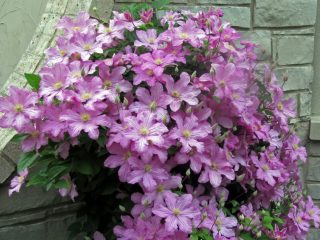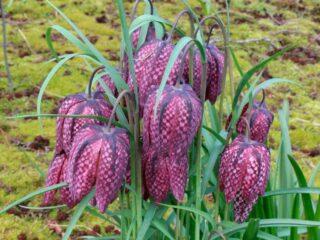Content
- 1 History of appearance
- 2 Description of gray fescue
- 3 Gray fescue varieties
- 4 Advantages and disadvantages
- 5 How to plant blue fescue
- 6 How to care for gray fescue
- 7 How does gray fescue reproduce?
- 8 How to replant blue fescue in the spring
- 9 How quickly does gray fescue grow?
- 10 What does fescue go with in a flower bed?
- 11 Conclusion
- 12 Reviews from gardeners about gray fescue
Gray fescue is an ornamental plant that is used to decorate country landscapes. The culture does not need complex care, but it requires minimal care.
History of appearance
Gray or blue fescue is a fairly young plant that gained popularity in cultivation only at the beginning of the twentieth century. The perennial is native to Europe. From there, the grass spread to the Baltic states, the Caucasus and beyond the Urals. The plant existed in nature before, but did not arouse interest among gardeners until the fashion for neat, even lawns appeared.
Description of gray fescue
Blue fescue (Festuca glauca) is a perennial plant of the Poaceae family. It has narrow linear leaves of gray-green or bluish color, reaching 60 cm above the ground surface. The roots of the plant are dense, but compact, located close to the surface.
In June and July, gray fescue blooms with gray-green inflorescences collected in soft panicles on a straight stem. At the end of the decorative period, the brushes acquire a light brown tint. The perennial grows well on dry, drained soils with a sandy-humus composition, and grows quietly on calcareous soil.

The brightness of the color of gray fescue depends on the weather - in cold summer the leaves of the perennial lighten and turn pale
Gray fescue can remain in one place for a long time - up to ten years. The bushes do not need frequent replanting, although if desired they can be divided every five years. If the plant is infected with a fungus or freezes, the procedure can be carried out ahead of time.
The perennial does not have bright blooms, but gardeners highly value it for its decorative leaves. Depending on the variety, the shade of the plates of the plant can be silver or bluish, bluish or deep blue with a steel tint.
Winter hardiness of gray fescue
According to official data, blue fescue is suitable for growing in climate zone 4. This means that, with minimal insulation, the crop can withstand cold temperatures down to -28 ° C.
Gardeners in reviews note that the perennial tolerates frost quite well, but reacts negatively to thaws and temperature changes.Under the snow, the root system of gray fescue often gets wet and begins to rot. Dealing with this problem can be quite difficult. To prevent rotting, it is recommended not only to thoroughly insulate the perennial, but also to ventilate it during periods of rising temperatures.
Dimensions and diameter of gray fescue
Gray fescue has a compact size. An adult perennial reaches an average of 30-50 cm above the ground, sometimes rising up to 60 cm.
At the same time, the bushes can spread quite widely in diameter. The perennial usually grows to 25-50 cm in diameter.
Blooming time of gray fescue
The flowering time of an ornamental perennial is determined by the plant variety. But usually the culture produces shoots with panicle inflorescences from early June to mid-summer. The individual buds of the perennial are very small, inconspicuous, and have an inexpressive brownish tint.
Despite this, during the decorative period, blue fescue looks very attractive. Numerous panicles of inflorescences give the bushes airiness and lightness.
Closer to August, very small seeds of the plant ripen. If the flower stalks are not trimmed in time, the crop will begin to actively spread throughout the area by self-seeding.
Application
Photos of gray fescue in a flower bed show that the crop is used very widely in garden design. Most often, perennials are planted in rockeries and rock gardens to fill empty space. The plant looks good against the background of stones, feels good on dry, light soils.

Fescue in the landscape combines with most other drought-tolerant plants in the neighborhood.
The crop can be planted in the background of flower beds consisting of low-growing perennials.In this case, discreet bushes will create a spectacular backdrop for brighter neighbors. The bluish leaves of the plant successfully set off both contrasting flowers and the rich greenery of perennials.

Blue fescue is used to create plain borders on the site
Photos of gray fescue in garden design demonstrate that the crop is grown not only in the soil, but also in closed containers. This allows you to place perennial grass in any area, even if the open ground is not suitable for its composition. In pots and spacious containers, the plant feels quite comfortable and does not require careful care.
Gray fescue varieties
The nuances of growing blue fescue and caring for it are largely determined by the characteristics of the variety. Several of the most popular varieties can be named.
Elijah Blue
A popular variety with gray-green leaves retains its decorative color well throughout the warm season. Suitable for planting in open ground and in pots. Forms semicircular lush bushes, stretches up to 60 cm above the ground.

The Elijah Blue variety blooms in June and July.
Golden Toupee
This unusual variety has lemon-yellow leaves in the spring and grayish-green leaves throughout the summer. Forms lush bushes, bears narrow inflorescences rising on stems up to 35 cm above the ground.

Outside the flowering period, Golden Tupi reaches 20 cm in height
Blue Select
A perennial variety with emerald blue leaves rises up to 30 cm above the ground. Flowering occurs in June and July, the panicles of the plant are grayish, soft, darkening after ripening.

Blue Select is an evergreen variety, the leaves retain their beautiful color even in winter
Advantages and disadvantages
Gray fescue is popular in Siberia and the central zone due to its cold resistance and general unpretentiousness. The plant is used for planting in areas with poor soil.

Gray fescue does not fade in direct sunlight
Pros:
- drought resistance;
- unpretentiousness;
- does not require abundant feeding;
- suppresses the development of weeds;
- grows quickly on the site;
- remains decorative throughout the year;
- easily gets along with other perennials.
Minuses:
- does not bear bright flowers;
- suppresses the development of low-growing crops in the neighborhood;
- does not tolerate trampling well.
How to plant blue fescue
On a perennial site, you need to choose a well-lit, open place. The plant needs dry soil, without swampiness, so the crop cannot be placed in lowlands or on the banks of a reservoir. It is better to plant it on a slight hill. If the soil is poor, this is not a problem, as long as the pH is within 6-7 units.
It is recommended to plant the plant in open ground no earlier than mid-May after the end of return frosts. The procedure is carried out according to the following scheme:
- Dig several holes in the area, slightly larger in volume than the root system of the seedlings.
- Fill the bottom of the recesses with a layer of drainage of 4-5 cm.
- Place a loose, moderately nutritious substrate into the holes.
- Place the seedlings in the center of the recesses, leaving the root collar flush with the ground or above the surface.
- Cover the plants with soil.
- Water generously.
Between individual plants, 15 cm of space is provided if you need to get a solid bluish carpet, and 30 cm if you want to leave gaps between the bushes.
How to care for gray fescue
In addition to good growing conditions, gray fescue needs to be properly cared for. It comes down to several main activities.
Watering
After sowing gray fescue or planting grown bushes in the ground, you need to provide them with sufficient moisture. After 2-3 weeks, the intensity of watering is reduced and subsequently water is added only during periods of prolonged drought.
Top dressing
The culture does not require abundant feeding. Fertilizers are applied a maximum of twice per season, using complex mineral preparations intended for lawn grass. The concentration is chosen to be minimal; due to the excess of nutrients, the crop reduces its decorative effect.
Trimming
There is no need to cut blue fescue in the spring, but it is recommended to comb out the bushes with a rake after wintering. This will get rid of dried and rotten leaves from last year.

It is worth trimming fescue inflorescences after they dry out, otherwise the perennial will scatter seeds throughout the area
Wintering
After the flowering period, the blue fescue begins to be prepared for wintering. The bushes are covered with a dense layer of straw or dry foliage at least 15 cm thick. If the winter is expected to be cold, you can additionally cover the flowerbed with spruce branches.
How does gray fescue reproduce?
Gray fescue can be propagated in several ways. It is recommended to divide rare varieties by rhizome from time to time; less valuable plants are allowed to be sown with seeds.
How to grow blue fescue from seeds
To plant blue fescue seeds, you need to cut off the panicles-inflorescences in time, dry them in a warm room and pour the grains into a paper bag. The crop is sown for seedlings in February. The seeds are first disinfected in a solution of potassium permanganate.
The crop should be planted in a sand-peat substrate to a depth of no more than 5 cm. During the spring, seedlings are grown on a lighted windowsill. The room temperature is kept cool so that the seedlings do not stretch out. With the onset of final warmth, the plants are transferred to open ground.
Reproduction of gray fescue by dividing the bush
It is recommended to divide blue fescue once every 3-4 years. At the beginning of autumn, the bushes are dug out of the ground and transplanted into a closed container for the whole winter. In February or March, the root system is carefully divided into several parts and the resulting plants are placed in a humus substrate. In May or early June, the seedlings are transferred back to the ground in separate holes.
How to replant blue fescue in the spring
If it is difficult to care for gray fescue in the spring after winter due to unsuitable conditions on the site, the crop needs to be moved to a new place. They do this as follows:
- Prepare a fresh hole on the site.
- Using a shovel, dig up a bush along with a lump of earth.
- Transfer the plant to a hole and cover it with soil and peat.
- Water generously.
The procedure must be carried out before the beginning of a heavy growing season.

Transplantation of gray fescue is carried out on a warm and dry, but cloudy day.
How quickly does gray fescue grow?
Gray fescue, after planting in open ground with seeds or mature seedlings, grows very quickly. Already in the fall of this year you can get lush and fully formed bushes.
What does fescue go with in a flower bed?
Almost any drought-resistant perennials can be planted next to gray fescue. Good neighbors for culture are:
- Veronica and the bell;
- splint;
- heuchera and hosta;
- tradescantia and lungwort;
- lavender and barberry.
You can place the plant close to sage, sedum and ornamental grasses.
Conclusion
Gray fescue is a discreet but beautiful perennial with high drought tolerance. It grows well in poor soil and does not require abundant feeding.
Reviews from gardeners about gray fescue








